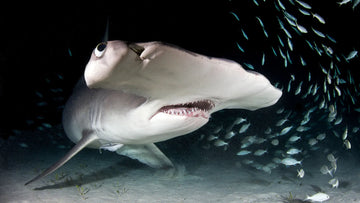There are simple ideas that just need to be applied to revolutionize a field of research. What if we could implant cameras in the sharks we study? This is what a group of researchers from the Universities of Hawaii and Tokyo thought. They have equipped various species of sharks with sensors (something they have been doing for many years) and underwater cameras that allow them to observe the behavior and habits of sharks in their natural environment.
The University of Hawaii has studied more than 400 sharks of various species over the past 20 years by implanting small ultrasonic transmitters that allow them to remotely monitor the sharks' movements. With this data, they can see on a screen the migration patterns, the exact depths to which each individual dives, and even the feeding habits, such as the date or frequency with which the sharks feed.
This technology has allowed them to discover that different species of sharks can form large schools, and they have even developed groundbreaking research by comparing data on the conservation status of species that feed on tiger sharks and Galapagos sharks, such as monk seals. But the simple implementation of underwater cameras has provided access to unknown data, confirmed theories and opened up new avenues of research. From now on, they will be able to compare data on their movements, migration and feeding patterns with images of those very moments.
Shark Lovers T-Shirts
VIEW MORE SHARK T-SHIRTS
"What we're trying to do," says Carl Meyer, a research associate at the University of Hawaii's Institute of Marine Biology, "is figure out more precisely what the role of sharks is in the ocean. It's about gaining a much deeper understanding of the ecological role of sharks, which is important for the health of the oceans and, by extension, for our own well-being."
By placing cameras on sharks' pectoral fins at eye level, new data about the behavior of these marine predators can be uncovered, answering long-standing questions about their mating patterns, relationships with other fish, species they feed on and why, feeding grounds, reproduction, etc.
In addition to sharks, the researchers are monitoring other marine predators, including tuna, to determine when, where and what fish they feed on. The team from both universities is developing a device that the large predators can ingest and collect data that will provide a better understanding of the diets of these fish, opening up new avenues of research to help focus conservation efforts and manage marine resources.
Fuentes: AGU























